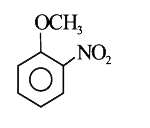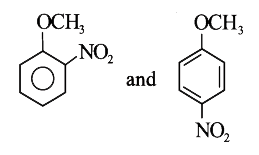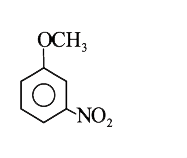Methyl phenyl ether reaction with HNO3 and H2SO4 results .




The correct Answer is:C
To solve the question regarding the reaction of methyl phenyl ether (anisole) with HNO3 and H2SO4, we can break down the process into clear steps:
1. Identify the Reactants:
- The reactant is methyl phenyl ether, also known as anisole (C6H5OCH3).
2. Understand the Reaction Conditions:
- The reagents used are HNO3 (nitric acid) and H2SO4 (sulfuric acid). This combination is typically used for nitration reactions.
3. Formation of the Electrophile:
- In the presence of HNO3 and H2SO4, the electrophile NO2+ (nitronium ion) is generated. The reaction can be summarized as:
HNO3+H2SO4→NO+2+HSO−4+H2O
4. Mechanism of Electrophilic Aromatic Substitution:
- Anisole has an OCH3 group, which is an activating group due to its +M (mesomeric) and +I (inductive) effects. This makes the aromatic ring more reactive towards electrophilic substitution.
- The nitronium ion (NO2+) will attack the aromatic ring of anisole. Due to the activating nature of the OCH3 group, the substitution will occur at the ortho and para positions relative to the OCH3 group.
5. Formation of Sigma Complex:
- When the nitronium ion attacks the aromatic ring, it forms a sigma complex (also known as an arenium ion or Wheland intermediate). This intermediate has a positive charge and is stabilized by resonance.
6. Deprotonation:
- The sigma complex will lose a proton (H+) to restore aromaticity. The electron pair from the bond between the hydrogen and the carbon will be used to form a double bond, resulting in the final product.
7. Final Products:
- The final products of the reaction will be ortho-nitroanisole and para-nitroanisole. The OCH3 group directs the electrophilic substitution to these positions.
Summary of Products:
- The products of the reaction of methyl phenyl ether (anisole) with HNO3 and H2SO4 are:
1. Ortho-nitroanisole
2. Para-nitroanisole
- The reactant is methyl phenyl ether, also known as anisole (C6H5OCH3).
- The reagents used are HNO3 (nitric acid) and H2SO4 (sulfuric acid). This combination is typically used for nitration reactions.
- In the presence of HNO3 and H2SO4, the electrophile NO2+ (nitronium ion) is generated. The reaction can be summarized as:
HNO3+H2SO4→NO+2+HSO−4+H2O
- Anisole has an OCH3 group, which is an activating group due to its +M (mesomeric) and +I (inductive) effects. This makes the aromatic ring more reactive towards electrophilic substitution.
- The nitronium ion (NO2+) will attack the aromatic ring of anisole. Due to the activating nature of the OCH3 group, the substitution will occur at the ortho and para positions relative to the OCH3 group.
- When the nitronium ion attacks the aromatic ring, it forms a sigma complex (also known as an arenium ion or Wheland intermediate). This intermediate has a positive charge and is stabilized by resonance.
- The sigma complex will lose a proton (H+) to restore aromaticity. The electron pair from the bond between the hydrogen and the carbon will be used to form a double bond, resulting in the final product.
- The final products of the reaction will be ortho-nitroanisole and para-nitroanisole. The OCH3 group directs the electrophilic substitution to these positions.
- The products of the reaction of methyl phenyl ether (anisole) with HNO3 and H2SO4 are:
1. Ortho-nitroanisole
2. Para-nitroanisole
Similar Questions
Knowledge Check
- Question 1 - Select One
Ethyl phenyl ether on reaction with excess HI yields
AEthyl iodide and iodobenzeneBEthyl iodide and phenolCEthyl alcohol and phenolDEthyl alcohol and iodobezene - Question 2 - Select One
The names of the salts formed by the reaction of
(i) Ca and HNO3
Ca and H2SO3 areA(i) Calcium nitrate (ii) Calium sulphateB(i) Calcium nitrite (ii) Calcium sulphiteC(i) Calcium nitrate (ii) Calcium sulphateD(i) Calcium nitrate (ii) Calcium sulphate - Question 3 - Select One
In the reaction SO2+2HNO3→H2SO+2NO2
AHNO3 is an oxidising agentBSO2 is an oxidising agentC(1) and (2) bothDNone of these
Anisole with conc. HNO3 and conc.H2SO4 gives
View SolutionThe names of the salts formed by the reaction of
(i) Ca and HNO3
Ca and H2SO3 areView SolutionIn the reaction
HNO3+HF→H2NO+3+F− base isView SolutionIn the reaction C+4HNO3→CO2+2H2O+NO2 , HNO3 acts as
View SolutionAttacking or reactive or electrophilic species in nitration of benzene is or In the nitration of benzene with concentrated HNO3 and H2SO4, the attck on ring is made by :
View Solution

